Biology Study guides, Class notes & Summaries
Looking for the best study guides, study notes and summaries about Biology? On this page you'll find 98670 study documents about Biology.
Page 3 out of 98.670 results
Sort by
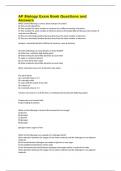
-
AP Biology Exam Book Questions and Answers
- Exam (elaborations) • 5 pages • 2024
-
- $9.89
- + learn more
AP Biology Exam Book Questions and Answers Which of the following is correct about isotopes of carbon? A) They are all radioactive. B) They contain the same number of neutrons but a different number of protons. C) They contain the same number of electrons but are chemically different because the number of neutrons are different. D) They are chemically identical because they have the same number of electrons. D) They are chemically identical because they have the same number of electrons. ...
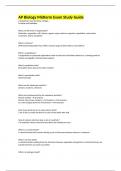
-
AP Biology Midterm Exam Study Guide
- Exam (elaborations) • 11 pages • 2024
-
- $10.49
- + learn more
AP Biology Midterm Exam Study Guide A hypothesis must be these 2 things... Testable and falsifiable What are the levels of organization? Molecules, organelles, cells, tissues, organs, organ systems, organism, population, community, ecosystem, biome, biosphere What is a theory? Well-tested explanation that unifies a broad range of observations and evidence What is a hypothesis? A supposition or proposed explanation made on the basis of limited evidence as a starting point for ...
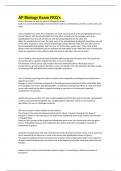
-
AP Biology Exam FRQ's (Unit 1)
- Exam (elaborations) • 3 pages • 2024
-
- $10.49
- + learn more
AP Biology Exam FRQ's (Unit 1) Describe the role of carbon in biological systems. Carbon is used to build biological macromolecules such as carbohydrates, proteins, nucleic acids, and lipids. (Unit 1) Explain how, when the membranes are fused, the polar parts of the phospholipids from one cell will interact with the phospholipids from the other cell and how the nonpolar parts of the phospholipids from one cell will interact with the phospholipids from the other cell. When the membranes ...
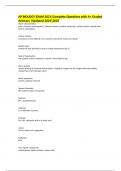
-
AP BIOLOGY EXAM 2021|Complete Questions with A+ Graded Answers |Updated 20242025
- Exam (elaborations) • 28 pages • 2024
-
- $10.89
- + learn more
AP BIOLOGY EXAM 2021|Complete Questions with A+ Graded Answers |Updated 20242025 Water characteristics polar, cohesion (hold together), adhesion (hold to another substance), surface tension, specific heat, heat of vaporization Surface Tension A measure of how difficult it is to stretch or break the surface of a liquid Specific Heat amount of heat absorbed or lost to change temperature by 1C Heat of Vaporization the quantity of heat required to convert 1 from liquid to gas ...
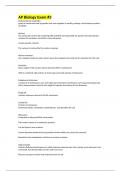
-
AP Biology Exam #3
- Exam (elaborations) • 6 pages • 2024
-
- $10.39
- + learn more
AP Biology Exam #3 Endomembrane organelles group of membranes and organelles that work together to modify, package, and transport proteins and lipids Nucleus The central part of the cell containing DNA and RNA and responsible for growth and reproduction - contains the nucleolus, chromatin, and nucleoplasm Contain genetic material The nucleus is enclosed by the nuclear envelope Nuclear envelope Has a double membrane and contains pores that regulate entry and exit of materials ...
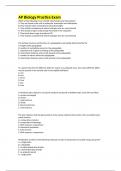
-
AP Biology Practice Exam
- Exam (elaborations) • 3 pages • 2024
-
- $9.89
- + learn more
AP Biology Practice Exam Which of the following is true of both mitochondria and chloroplasts? A. They are found in the cells of eukaryotic autotrophs and chloroplasts B. They include stacks of membranes that absorb light C. They include compartments where hydrogen ions are concentrated D. They produce sugars using energy harvested in the cytoplasm E. They break down sugar to produce ATP C. They include compartments where hydrogen ions are concentrated The tertiary structure and func...
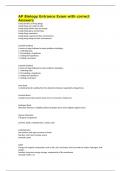
-
AP Biology Entrance Exam with correct Answers
- Exam (elaborations) • 6 pages • 2024
-
- $10.39
- + learn more
AP Biology Entrance Exam with correct Answers Characteristics of living things Living things are made of cells. Living things obtain and use energy. Living things grow and develop. Living things reproduce. Living things respond to their environment. Living things adapt to their environment. Scientific Method A series of steps followed to solve problems including... 1. collecting data 2. formulating a hypothesis 3. testing the hypothesis, 4. stating conclusions. Scientific M...
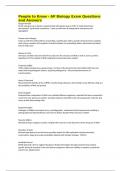
-
People to Know - AP Biology Exam Questions and Answers
- Exam (elaborations) • 2 pages • 2024
-
- $9.59
- + learn more
People to Know - AP Biology Exam Questions and Answers Gregor Mendel Monk who grew up in Austria, experimented with garden peas in 1857 to study inheritance, documented "particulate mechanism", came up with laws of independent assortment and segregation. Thomas Hunt Morgan Came up with first solid evidence associating a specific gene with a specific chromosome by working with various varieties of Drosophila; invented notation for symbolizing alleles; discovered sex-linked trait of whit...
![AP Biology [Practice AP Exam] Questions and Answers (Graded A)](/docpics/5215127/6639c50ad8739_5215127_121_171.jpeg)
-
AP Biology [Practice AP Exam] Questions and Answers (Graded A)
- Exam (elaborations) • 5 pages • 2024
-
- $9.89
- + learn more
AP Biology [Practice AP Exam] Questions and Answers (Graded A) [D] interactions between amino acids present in the polypeptide. [2] The tertiary structure and function of a polypeptide is principally determined by the: ----------------------------------------------- [A] length of the polypeptide. [B] number of nucleotides present in the polypeptide. [C] repeated units of glycerol making up the polypeptide. [D] interactions between amino acids present in the polypeptide. [E] numbe...
![AP Biology [Practice AP Exam] Questions and Answers (Graded A)](/docpics/5215118/6639c4945a736_5215118_121_171.jpeg)
-
AP Biology [Practice AP Exam] Questions and Answers (Graded A)
- Exam (elaborations) • 26 pages • 2024
-
- $11.59
- + learn more
AP Biology [Practice AP Exam] Questions and Answers (Graded A) [C] They Include compartments where hydrogen ions are concentrated. [1] Which of the following is true of both mitochondria and chloroplasts? ----------------------------------------------- [A] They are found in the cells of eukaryotic autotrophs and heterotrophs. [B] They include stacks of membranes that absorb light. [C] They Include compartments where hydrogen ions are concentrated. [D] They produce sugars using energ...

How much did you already spend on Stuvia? Imagine there are plenty more of you out there paying for study notes, but this time YOU are the seller. Ka-ching! Discover all about earning on Stuvia


